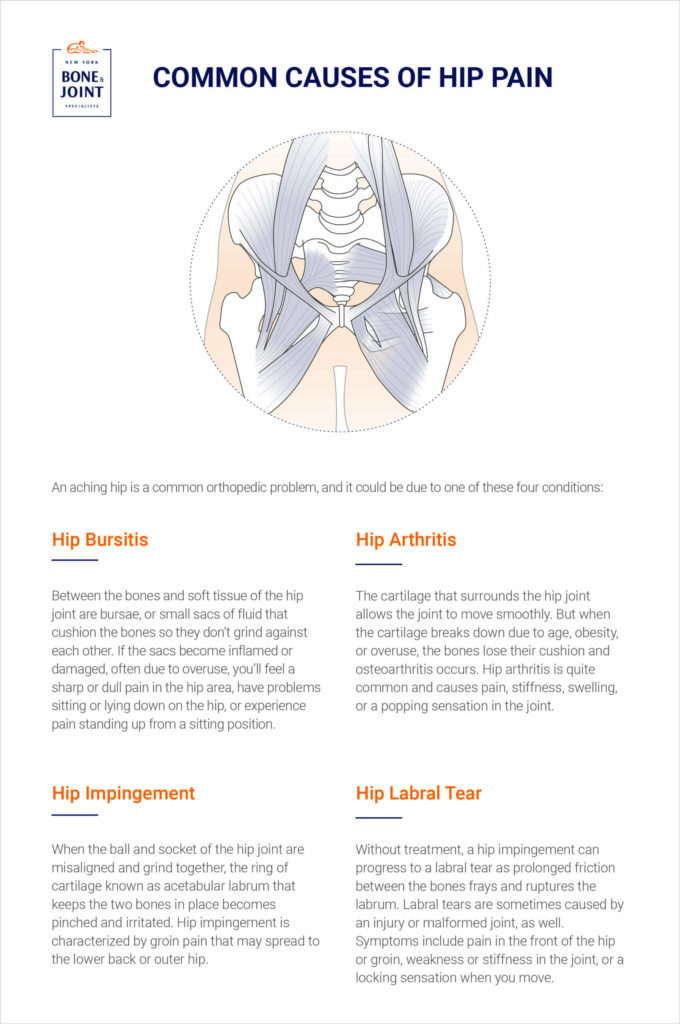An aching hip is a common orthopedic problem, and it could be due to one of these four conditions.
As orthopedic specialists, we frequently see patients complaining of hip pain, which isn’t surprising considering how often we use our hips to walk, climb stairs, and exercise.
Hips are ball and socket joints in which a ball on top of the femur (thigh bone) nestles into a socket in the acetabulum (hip bone). Surrounding the joint is a network of articular cartilage that prevents the bones from rubbing against each other and keeps the joint moving smoothly. Because of its structure and range of motion, the hip joint is especially vulnerable to overuse, causing pain that typically radiates from the outer hip and into the groin area. Hip pain can be caused by several common orthopedic conditions, which we explore here.
What’s Causing Your Hip Pain?

An orthopedic specialist will diagnose the exact cause of your hip pain with a physical examination that includes manipulating your hip to assess its range of motion. An X-ray or MRI may also be performed to get an image of your hip joint. After a thorough evaluation, your doctor can tell you if your hip pain is due to one of these four ailments:
Hip Bursitis
Between the bones and soft tissue of the hip joint are bursae, or small sacs of fluid that cushion the bones so they don’t grind against each other. If the sacs become inflamed or damaged, often due to overuse, you’ll feel a sharp or dull pain in the hip area, have problems sitting or lying down on the hip, or experience pain standing up from a sitting position. Conservative treatment with a regimen of physical therapy, cold compresses, anti-inflammatory medications, and/or corticosteroid injections usually heals hip bursitis within weeks. If conservative therapy fails to resolve the pain, your doctor may recommend a minimally invasive arthroscopic procedure to extract fluid from the bursa or remove it.
Hip Arthritis
The cartilage that surrounds the hip joint allows the joint to move smoothly. But when the cartilage breaks down due to age, obesity, or overuse, the bones lose their cushion and osteoarthritis occurs. Hip arthritis is quite common and causes pain, stiffness, swelling, or a popping sensation in the joint. Non-surgical treatment for hip arthritis ranges from physical therapy and lifestyle changes to corticosteroid injections. If those methods don’t work, one surgical option would be a hip resurfacing procedure that removes the damaged cartilage and socket. A metal mold where the rounded head of the femur bone fits is put in the socket’s place. Or, your surgeon may recommend a total hip replacement if the joint is severely damaged.
Hip Impingement
When the ball and socket of the hip joint are misaligned and grind together, the ring of cartilage known as acetabular labrum that keeps the two bones in place becomes pinched and irritated. Femoroacetabular impingement (FAI) is characterized by groin pain that may spread to the lower back or outer hip. The first line of treatment for a hip impingement is stopping strenuous exercise, followed by physical therapy to stretch and strengthen the surrounding muscles and corticosteroid injections if necessary. Depending upon the severity of the hip impingement, you may need arthroscopic surgery to repair the labrum or remove bone spurs. The most severe cases would require a partial or total hip replacement.
Hip Labral Tear
Without treatment, a hip impingement can progress to a labral tear as prolonged friction between the bones frays and ruptures the labrum. Labral tears are sometimes caused by an injury or malformed joint, as well. Symptoms include pain in the front of the hip or groin, weakness or stiffness in the joint, or a locking sensation when you move. Physical therapy and anti-inflammatory medication should reduce pain, but if conservative treatment doesn’t resolve the discomfort, you may need surgery. Fortunately, arthroscopic surgery to repair a labral tear and stabilize the joint with bioabsorbable clips is minimally invasive. Surgery is followed by physical therapy that will have you back to your normal activities within eight to 12 weeks.
We’re the Hip Specialists
At New York Bone & Joint Specialists, we have physicians and physical therapists who focus on hip disorders and many other orthopedic conditions. Using the latest diagnostic techniques, we’ll pinpoint the cause of your condition and create a treatment plan to get you pain-free as soon as possible.
We are open for both in-person and telemedicine appointments, and we’ve instituted strict guidelines to ensure your safety. Contact us today.




